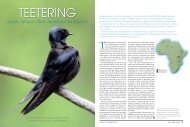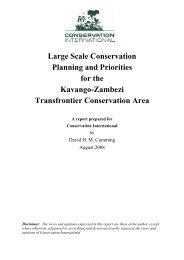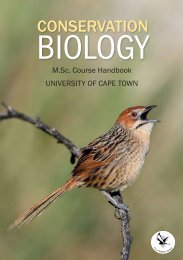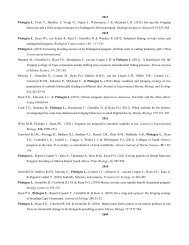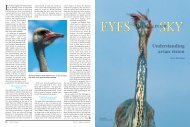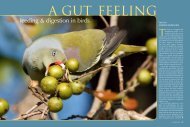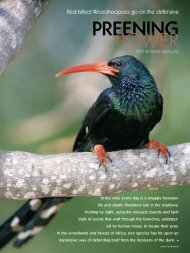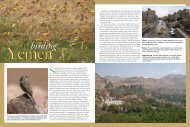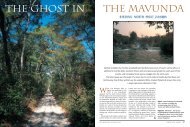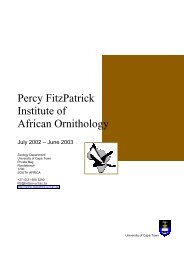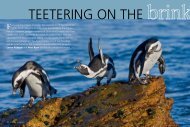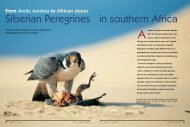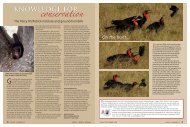Highland low-down: birding Zimbabwe's Eastern Highlands
Highland low-down: birding Zimbabwe's Eastern Highlands
Highland low-down: birding Zimbabwe's Eastern Highlands
You also want an ePaper? Increase the reach of your titles
YUMPU automatically turns print PDFs into web optimized ePapers that Google loves.
which it is named.<br />
On the <strong>low</strong>er northern<br />
slopes, hidden in<br />
high-rainfall miombo<br />
woodland, are the<br />
Inn on the Vumba<br />
and White Horse Inn.<br />
The nearby self-catering<br />
chalet at Cloud<br />
Seven is surrounded<br />
by 50 hectares of<br />
woodland networked starred robin<br />
with footpaths. In<br />
this <strong>low</strong>er altitude woodland, Barred Owl,<br />
Whyte’s Barbet, Lesser and Sharp-billed<br />
honeyguides, Little Spotted Woodpecker,<br />
Miombo Grey, Rufous-bellied and Grey<br />
Penduline tits, Spotted Creeper, Miombo<br />
Rock Thrush, African Moustached and<br />
Red-winged warblers, Striped, Tree and<br />
Wood pipits, Western Violet-backed<br />
Sunbird, East African Swee and Cabanis’<br />
Bunting may be seen.<br />
The moister slopes higher up are<br />
cloaked in montane forest. The idyllic<br />
Bvumba Botanical Gardens, where you<br />
are likely to be welcomed by a troop of<br />
samango monkeys gambolling on the<br />
lawns, is the place to go if camping.<br />
Alternative forest-edge accommodation<br />
includes self-catering chalets at Culemburg<br />
and Seldomseen, the more up-market<br />
Eden Lodge, and for those with deep<br />
pockets, the world-renowned Leopard<br />
Rock Hotel. Everywhere, paths plunge<br />
into the gloomy interior of forest patches<br />
that are unusually rich in birds.<br />
Born in the Bvumba, Peter Mwadziwana<br />
has worked at Seldomseen for the<br />
past 20 years and knows the forest birds<br />
intimately. A guided<br />
walk with him is worth<br />
anyone’s time, particularly<br />
if you are having<br />
trouble finding the<br />
ever-elusive wynnerton’s<br />
Robin. A quiet<br />
and gentle man, he will<br />
lead you on a s<strong>low</strong> and<br />
stealthy stroll through<br />
his neck of the woods.<br />
As we entered the forest,<br />
Cinnamon and<br />
Tambourine doves<br />
exploded from the<br />
undergrowth as dark,<br />
flashing shapes, flutter- spotted Creeper<br />
ing to rest somewhere<br />
unseen. A Blue-spotted Dove hooted<br />
mournfully some distance away. Soon we<br />
found ourselves in the midst of a bird<br />
party, heralded by the restlessly flitting<br />
African White-tailed<br />
Flycatcher. Yel<strong>low</strong>streaked<br />
Bulbuls clambered<br />
through the<br />
foliage, tapping at dry<br />
leaves, pausing only<br />
to perform their curious<br />
habit of flicking<br />
open one wing.<br />
Chirinda Apalises,<br />
easily confusable with<br />
peter steyn the female of the<br />
local subspecies of<br />
Bar-throated Apalis (which lacks a bar on<br />
the throat), hopped through the canopy<br />
with Yel<strong>low</strong>-throated Warblers and a<br />
Black-fronted Bushshrike. A Scalythroated<br />
Honeyguide perched unobtrusively<br />
on a looping liana, while Collared<br />
and Olive sunbirds twittered around a<br />
f<strong>low</strong>ering shrub. An Orange Ground<br />
Thrush rustled the leaf-litter to one side,<br />
and a party of Roberts’ Prinias chattered<br />
noisily further off. After two hours of<br />
pausing and peering hopefully into the<br />
gloomy undergrowth, I thought<br />
Swynnerton’s Robin would remain true<br />
to form. But then, with a soft ‘prrup’ of<br />
its wings, it appeared before us, a dumpy,<br />
olive-grey shadow hopping busily about<br />
and flicking away leaves in search of<br />
insects. A confiding little bird, it paid no<br />
attention to us, offering only fleeting<br />
glimpses of its orange belly and distinctive<br />
white collar.<br />
The Bunga Forest is a good spot for<br />
Delegorgue’s Pigeon, Narina Trogon,<br />
Starred Robin and, in grassy clearings,<br />
twinspots and Red-faced Crimsonwing.<br />
On the forest fringes and in gardens,<br />
look out for Whiteeared<br />
Barbet and<br />
Golden-rumped Tinker<br />
Barbet, Heuglin’s Robin,<br />
Bronze, Malachite and<br />
Yel<strong>low</strong>-bellied sunbirds,<br />
and the Gorgeous<br />
Bushshrike.<br />
A favoured hang-out<br />
of the raucous Silverycheeked<br />
Hornbills is<br />
the forest bordering the<br />
magnificent 19-hole<br />
Leopard Rock golfcourse.<br />
These huge,<br />
eye-catching birds are<br />
peter steyn nowhere common, as<br />
they range about in<br />
search of fruiting trees. Vestiges of montane<br />
grassland are home to breeding Blue<br />
Swal<strong>low</strong>s in summer. With this habitat<br />
under no formal protection and <br />
Systematic list of bird species<br />
mentioned in this article<br />
Long-crested Eagle Lophaetus occipitalis<br />
Brown Snake Eagle Circaetus cinereus<br />
Southern Banded Snake Eagle C. fasciolatus<br />
Palm-nut Vulture Gypohierax angolensis<br />
Augur Buzzard Buteo augur<br />
Lizard Buzzard Kaupifalco monogrammicus<br />
Taita Falcon Falco fasciinucha<br />
Dickinson’s Kestrel F. dickinsoni<br />
Shelley’s Francolin Francolinus shelleyi<br />
Great Snipe Gallinago media<br />
Delegorgue’s Pigeon Columba delegorguei<br />
Blue-spotted Dove Turtur afer<br />
Tambourine Dove T. tympanistria<br />
Cinnamon Dove Aplopelia larvata<br />
Livingstone’s Lourie Tauraco livingstonii<br />
Barred Cuckoo Cercococcyx montanus<br />
Green Coucal Ceuthmochares aereus<br />
Barred Owl Glaucidium capense<br />
Pel’s Fishing Owl Scotopelia peli<br />
Freckled Nightjar Caprimulgus tristigma<br />
Scarce Swift Schoutedenapus myoptilus<br />
Narina Trogon Apaloderma narina<br />
Swal<strong>low</strong>-tailed Bee-eater Merops hirundineus<br />
Silvery-cheeked Hornbill Bycanistes brevis<br />
White-eared Barbet Stactolaema leucotis<br />
Whyte’s Barbet S. whytii<br />
Golden-rumped Tinker Barbet Pogoniulus bilineatus<br />
Scaly-throated Honeyguide Indicator variegatus<br />
Lesser Honeyguide I. minor<br />
<strong>Eastern</strong> Honeyguide I. meliphilus<br />
Sharp-billed Honeyguide Prodotiscus regulus<br />
Little Spotted Woodpecker Campethera cailliautii<br />
African Broadbill Smithornis capensis<br />
Angola Pitta Pitta angolensis<br />
Blue Swal<strong>low</strong> Hirundo atrocaerulea<br />
<strong>Eastern</strong> Saw-wing Swal<strong>low</strong> Psalidoprocne orientalis<br />
White-breasted Cuckooshrike Coracina pectoralis<br />
Grey Cuckooshrike C. caesia<br />
Square-tailed Drongo Dicrurus ludwigii<br />
African Golden Oriole Oriolus auratus<br />
Miombo Grey Tit Parus griseiventris<br />
Rufous-bellied Tit P. rufiventris<br />
Grey Penduline Tit Anthoscopus caroli<br />
Spotted Creeper Salpornis spilonotus<br />
Yel<strong>low</strong>-streaked Bulbul Phyllastrephus flavostriatus<br />
Slender Bulbul P. debilis<br />
Stripe-cheeked Bulbul Andropadus milanjensis<br />
Yel<strong>low</strong>-spotted Nicator Nicator gularis<br />
Orange Ground Thrush Zoothera gurneyi<br />
Miombo Rock Thrush Monticola angolensis<br />
Mocking Chat Thamnolaea cinnamomeiventris<br />
Heuglin’s Robin Cossypha heuglini<br />
Starred Robin Pogonocichla stellata<br />
Swynnerton’s Robin Swynnertonia swynnertoni<br />
Mashona Hyliota Hyliota australis<br />
African Yel<strong>low</strong> Warbler Chloropeta natalensis<br />
Barratt’s Warbler Bradypterus barratti<br />
58 ZIMBABWE’S EASTERN HIGHLANDS<br />
africa – Birds & Birding<br />
Broad-tailed Warbler Schoenicola brevirostris<br />
Yel<strong>low</strong>-throated Warbler Seicercus ruficapillus<br />
Bar-throated Apalis Apalis thoracica<br />
Chirinda Apalis A. chirindensis<br />
Black-headed Apalis A. melanocephala<br />
Red-faced Crombec Sylvietta whytii<br />
Green-capped Eremomela Eremomela scotops<br />
African Moustached Warbler Melocichla mentalis<br />
Singing Cisticola Cisticola cantans<br />
Red-faced Cisticola C. erythrops<br />
Short-winged Cisticola C. brachyptera<br />
Red-winged Warbler Heliolais erythroptera<br />
Roberts’ Prinia Prinia robertsi<br />
Blue-grey Flycatcher Muscicapa caerulescens<br />
Fan-tailed Flycatcher Myioparus plumbeus<br />
Vanga Flycatcher Bias musicus<br />
Mozambique Batis Batis soror<br />
Woodwards’ Batis B. fratrum<br />
Wattle-eyed Flycatcher Platysteira peltata<br />
Blue-mantled Flycatcher Trochocercus cyanomelas<br />
African White-tailed Flycatcher T. albonotatus<br />
Long-tailed Wagtail Motacilla clara<br />
Striped Pipit Anthus lineiventris<br />
Tree Pipit A. trivialis<br />
Wood Pipit A. nyassae<br />
Yel<strong>low</strong>-throated Longclaw Macronyx croceus<br />
Red-backed Shrike Lanius collurio<br />
Bomakierie Telophorus zeylonus restrictus<br />
Gorgeous Bushshrike T. quadricolor<br />
Black-fronted Bushshrike T. nigrifrons<br />
White Helmetshrike Prionops plumatus<br />
Red-billed Helmetshrike P. retzii<br />
Chestnut-fronted Helmetshrike P. scopifrons<br />
Gurney’s Sugarbird Promerops gurneyi<br />
Malachite Sunbird Nectarinia famosa<br />
Bronze Sunbird N. kilimensis<br />
Purple-banded Sunbird N. bifasciata<br />
Miombo Double-collared Sunbird N. manoensis<br />
Yel<strong>low</strong>-bellied Sunbird N. venusta<br />
Olive Sunbird N. olivacea<br />
Collared Sunbird Anthreptes collaris<br />
Blue-throated Sunbird A. reichenowi<br />
Western Violet-backed Sunbird A. longuemarei<br />
Golden Weaver Ploceus xanthops<br />
Fire-crowned Bishop Euplectes hordeaceus<br />
Golden-backed Pytilia Pytilia afra<br />
Green Twinspot Mandingoa nitidula<br />
Red-faced Crimsonwing Cryptospiza reichenovii<br />
Nyasa Seedcracker Pyrenestes minor<br />
Red-throated Twinspot Hypargos niveoguttatus<br />
Grey Waxbill Estrilda perreini<br />
East African Swee E. quartinia<br />
Streaky-headed Canary Serinus gularis<br />
Black-eared Canary S. mennelli<br />
Cabanis’s Bunting Emberiza cabanisi<br />
Cape Bunting E. capensis smithersii<br />
1997 – volume 2, numBer 6<br />
threatened by forestry, the spread of invasive<br />
alien trees, and general development,<br />
their days here must be numbered.<br />
With a checklist of over 250 species, the<br />
Bvumba area offers the best of highland<br />
<strong>birding</strong> in comfortable surrounds.<br />
honde valley<br />
and nyanga<br />
Should you fancy some forest <strong>birding</strong><br />
off the beaten track, wend your way<br />
<strong>down</strong> the Honde River valley to the<br />
Above roberts’ prinia, an eastern <strong>Highland</strong>s ‘special’.<br />
Aberfoyle Tea Estate, whose club operates<br />
as a small and rustic hotel. Here,<br />
rolling hills of neatly clipped tea-bushes<br />
give way to luxuriant montane forest on<br />
the eastern slopes of the Nyanga mountains.<br />
Paths more often frequented by<br />
bushpigs fol<strong>low</strong> rushing mountain<br />
streams where Long-tailed Wagtails bob<br />
on glistening rocks. A local oddity is<br />
Zimbabwe’s only Palm-nut Vulture,<br />
which has appeared each evening for<br />
the past three years to roost in a grove<br />
of tall eucalypts.<br />
The Nyanga National Park, which<br />
is not unlike a dull section of the<br />
Drakensberg foothills, conserves an<br />
expanse of montane grassland particularly<br />
important for Blue Swal<strong>low</strong>s, and is one of<br />
the few localities where Scarce Swifts may<br />
be seen. Unfortunately, extensive areas are<br />
suffering rampant invasion by alien pine<br />
and wattle trees from the green cancer of<br />
forestry that surrounds the park.<br />
A showcase of avian diversity, the<br />
<strong>Eastern</strong> <strong>Highland</strong>s nonetheless face the all<br />
too familiar threats associated with devel-<br />
opment and a burgeoning population.<br />
The persistence of many species in habitats<br />
that were never very extensive, and<br />
are now much fragmented, will depend<br />
on the extent to which ecotourism can<br />
realize an alternative income from the<br />
land they occupy. With its diversity of<br />
habitats, natural wonders, large bushveld<br />
wilderness areas and healthy wildlife populations,<br />
Zimbabwe has immense potential<br />
as a tourist destination. The <strong>Eastern</strong><br />
<strong>Highland</strong>s are an important component<br />
of that diversity and allure.<br />
<br />
ZIMBABWE’S EASTERN HIGHLANDS<br />
peter steyn<br />
59



